Looking ahead into 2021, the ongoing effects of the pandemic continue to impact on countries and their economies. For the Pacific, with relatively vulnerable public health systems and geographical remoteness, Governments moved quickly to close borders in order to avoid large scale community transmission, potential collapse of health systems and most importantly to avoid any fatalities due to COVID-19.
Notwithstanding the Pacific’s relative success in preventing and containing the spread of COVID-19, the region continues to face a range of socio-economic challenges. The pandemic has resulted in sudden stop to highly vulnerable economies given social distancing and other public health measures that were put in place to mitigate its impact as well as response actions including border closures, lockdown, and curfews. These events have had unintended consequences resulting in business closures, increased unemployment, and social issues such as increasing rates of domestic violence.
In lights of these issues, the main aim of this report is to provide an overview of the socio-economic impact of COVID 19 pandemic and consequent fiscal space or parameters needed for supporting affected sectors in Samoa. A comparative analysis against three selected PICs including Fiji, Tonga and Tuvalu highlights the extent of COVID 19 impact on these economies and possible fiscal responses that may be replicated for other PICs. There are five key sections of the report which include the following:
- Section 1: Overview of approach and methodology;
- Section 2: Outlines the socio-economic characteristics, existing health issues and systems and cost implications of access to a COVID 19 vaccine for Samoa and the 3 comparative PICs;
- Section 3: Presents the macroeconomic context of the selected PICs with specific focus on balance of payments, employment & inflation and output growth scenarios;
- Section 4: presents the fiscal implications of COVID 19 on government budget operations, debt sustainability and fiscal space;
- Section 5 outlines possible financing options available to the PICs to supplement their fiscal budget and;
- Section 6 summarizes key findings of the report and further quantitative analysis needed under Phase 2 given identified socio economic challenges and fiscal parameters under Phase 1.
All four PICs are employing available policy measures and initiatives, with development partners and the region’s private sector (such as the superfunds and pension funds) support, to respond to COVID-19. These measures as outlined in the report include expansionary fiscal and monetary policies, easing of financial/banking, and superannuation measures for social protection, and economic stimulus. Further detailed quantitative analysis of identified fiscal measures and updated fiscal parameters will be undertaken under Phase 2 of this study and ensure alignment with the following UN 5 five pillars given the focus on socio-economic response to COVID 19:
-
- Health First: Protecting Health Services and Systems during the Crisis
- Protecting People: Social Protection and Basic Services
- Economic Recovery: Protecting Jobs, Small and Medium-Sized Enterprises, and the Most Vulnerable Productive Actors
- Macroeconomic Response and Multilateral Collaboration
- Social Cohesion and Community Resilience
